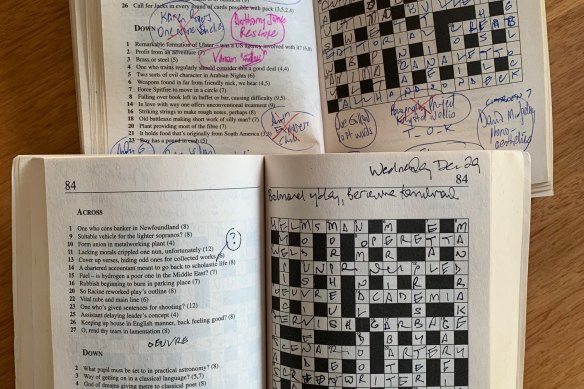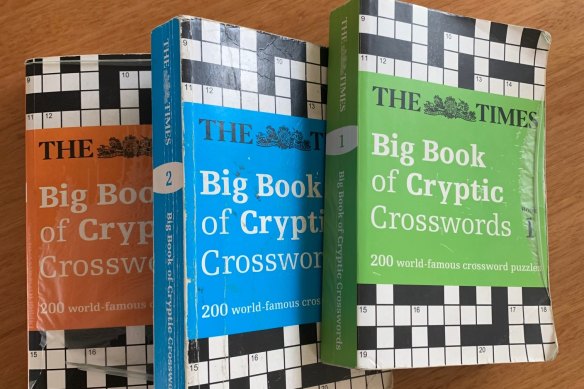My plague journals run from August 2019 until August 2022, three years of curfews and lockdowns, vaccines and staycations. Plus 606 crosswords, or 202 per book, being the marathon I solved along the way. The trilogy is dog-eared, its grids and margins loaded with my earlier scribble: the anagram wheels and nib-testing squiggles, the fugitive ideas and to-do lists – my life, in short, squashed to fit.
Call me Nostradamus, but I must have sensed the virus coming. How else to explain my impulse purchase of five whole volumes, The Times Big Book of Cryptic Crosswords (Books 1 to 5, from green to purple), back when Corona was a Mexican beer.
A glimpse inside David Astle’s COVID-19 crossword marathon.
That was July 2019, a job lot at Dymocks. If alien overlords arrived at the weekend, at least I had a life’s supply of puns and other treats, a chance to hide in my storm cellar to chew untold deceptions. I began Book 1, Puzzle 1, on August 1, never realising the alien force was just months away, via a questionable bat in Wuhan.
To be clear, Samuel Pepys kept a plague journal. A proper one. The naval clerk put quill to paper from 1660 to 1669, recording the bubonic threat across London, how “fears of the Sicknesse” entered every heart. How citizens tried shag tobacco to keep the stench at bay. He recorded the burials, the melancholy. By contrast, I solved 606 puzzles across 1069 days, noting the Zoom fatigue in the borders, the national cabinets, the cabin fever, the daily numbers.
Still, the trilogy lends a glimpse of the blur we’ve all endured. We still endure. Late 2019, tackling a pesky homophone, I noted how some acronym called COVID began to hog my newsfeed. By March 2001, I was decoding charade clues and other formulas in a bid to limit the doomscrolling.
David Astle’s pandemic crossword supply.
The crosswords kept me sane. Or to quote Book 1, Puzzle 194, 14-down: Violent upheaval in which many stay calm, remarkably (9) The wordplay entails many (or C, one hundred) blending with STAY CALM to label the CATACLYSM the virus soon rendered, as I jumbled letters in the hurricane’s eye.
Nor was that clue the marathon’s only voodoo vibe. Take RIOT ACT in Puzzle 135 (Book 1): Required reading when there’s disorder (4,3). Soon the books shaped as vital reading, a key diversion to deafen the bell curve. By Book 2, midway into 2020, Puzzle 71 eerily predicted the first Pfizer arrival: Where dispensers work fast, limiting damage (8). A container clue this time, planting HARM in PACY to make PHARMACY.
Jotted across each grid, acting as quasi-diary, is the date of each puzzle’s solving, plus a throwaway phrase to distinguish that day: Get new dog; Ash wins Wimbledon; Numbat dies. Numbat was my genial mother-in-law, her nickname born of the kids as toddlers struggling to say Nana Pat. I missed attending her death-bed due to an isolation haul in a Sydney hotel – Book 3, Puzzle 32, 25-down: Delay guy’s visit (4). A triple-definition. STAY.
As for the setters, the phantom army behind these crosswords, they nursed their own anxieties. First published in 1999, the sequence murmurs dread of Y2K: Insect likely to be problematic in a year = BUG. Thanks to hindsight, the fear feels almost cute. Don’t fret, I replied to the compiler – the bug is a bugaboo. Your panic is groundless, the whole furore a furphy. Far wiser to avoid Chinese bats in 2019, I advised the past, or at least buy a stack of crosswords and wait the pestilence out.
To read more from Spectrum, visit our page here.
The Morning Edition newsletter is our guide to the day’s most important and interesting stories, analysis and insights. Sign up here.
Read more Wordplay
- That aching feeling after finishing a good book? There’s a word for that
- Ever experienced Samstun or iPhobia? Probably, even if you don’t know it
- What does a person have to do to get their name in the dictionary?
- What’s the difference between a sport and a game?
Most Viewed in Culture
From our partners
Source: Read Full Article


